Decompensated Heart Failure: Causes, Symptoms, and Treatment
VerifiedAdded on 2023/04/23
|14
|4857
|142
AI Summary
This essay discusses the case of Brian James, a 73-year-old male who presented with acutely decompensated heart failure. It explores the causes, symptoms, and treatment of the condition, with a focus on diuresis and discharge planning. The importance of patient education and follow-up care is also emphasized.
Contribute Materials
Your contribution can guide someone’s learning journey. Share your
documents today.
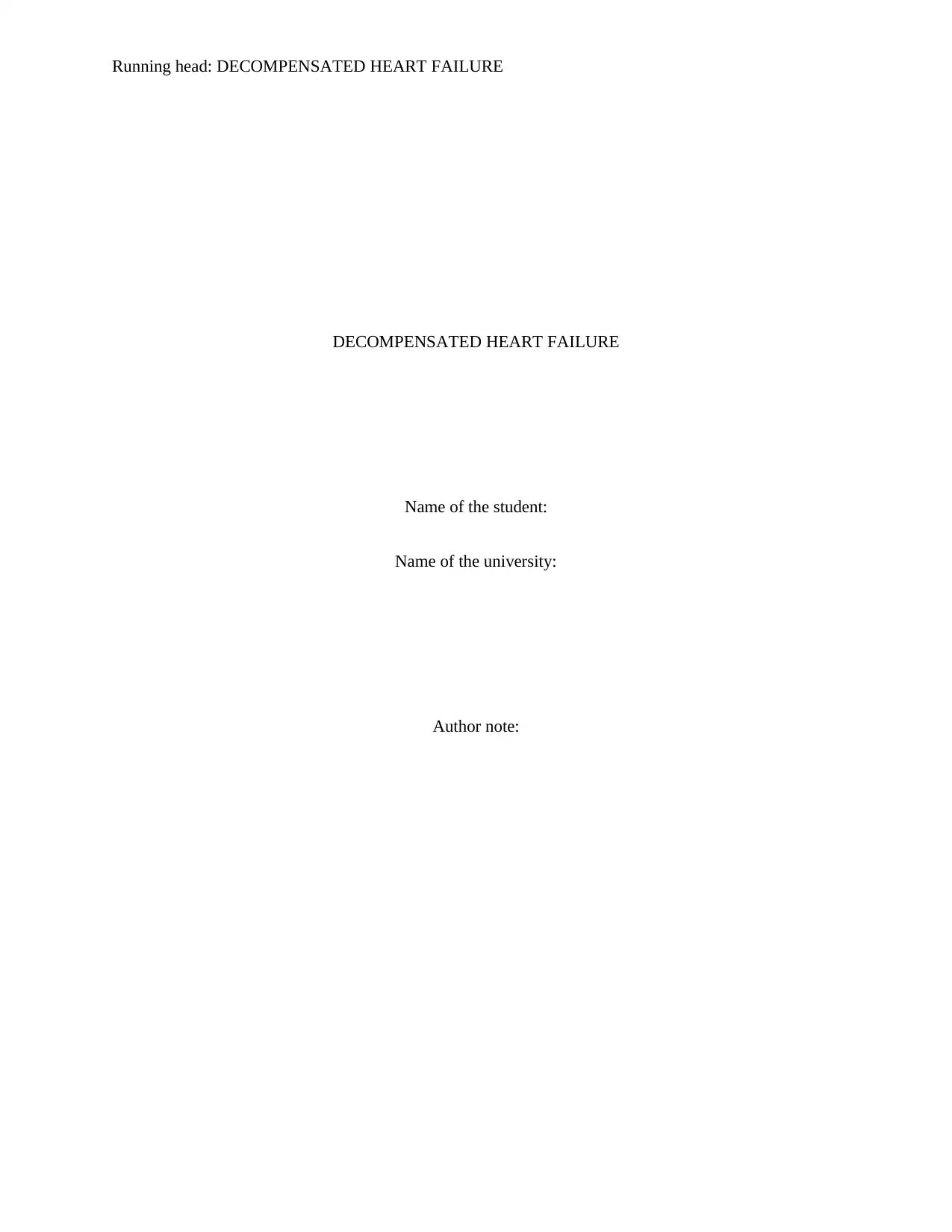
Running head: DECOMPENSATED HEART FAILURE
DECOMPENSATED HEART FAILURE
Name of the student:
Name of the university:
Author note:
DECOMPENSATED HEART FAILURE
Name of the student:
Name of the university:
Author note:
Secure Best Marks with AI Grader
Need help grading? Try our AI Grader for instant feedback on your assignments.

1
DECOMPENSATED HEART FAILURE
Brian James is a 73-year-old male who was brought in by ambulance to the Emergency
Department. He was presented with shortness of breath, swollen ankles, crackles bilaterally in his
posterior lung bases. He suffered from recent increase in weight and his rhythm was noted as sinus
tachycardia (heart rate 105). His relevant history included a new diagnosis of heart failure 4 months ago
with an EF of 39%, ischaemic heart disease, hypertension, obesity. He is a current smoker. Brian has
presented with acutely decompensated heart failure and triggering factor for his clinical presentation is
non-adherence to treatment. Several interventions are employed during the admission of an acutely
overloaded patient with immediate goals being to improve the symptoms of decompensated heart failure,
restore oxygenation to improve overall organ perfusion and to limit any cardiac or renal impairment (Jha
et al., 2018). The treatment focuses on reversing pulmonary and peripheral congestion, considering
potential precipitating causes and optimizing the therapeutic approach. The two major interventions that
will be discussed during this essay in the context of Brian’s acutely decompensated heart failure include
diuresis with medical therapy as an in-patient and discharge planning and patient education facilitated by
the registered nurse.
Acute decompensate heart failure (ADHF) is considered to be one of the most common causes for
hospital admissions. Studies have found that patients affected with this disorder have longer hospital stays
and even remain highly vulnerable towards in-hospital as well as post-discharge mortality and morbidity
(Qavi et al., 2015). Fluid overload or congestion is found to be the classical clinical feature of the patients
who present with ADHF to the admission wards. In some of the patients, pulmonary congestion is seen to
take place at a very rapid rate. Researchers have opined that such clinical conditions are found to be
intricately associated with patients who face sudden increase in the left ventricular filling pressures
(Brambett et al., 2017)). Some of the most important causal factors that had been recognized to be
contributing to such situation are acute myocardial ischemia and uncontrolled hypertension. The
preliminary assessments that were conducted of the patient named Brian showed that he had hypertension
and had history of myocardial infarction. Studies have found that in such circumstances, the edema is
DECOMPENSATED HEART FAILURE
Brian James is a 73-year-old male who was brought in by ambulance to the Emergency
Department. He was presented with shortness of breath, swollen ankles, crackles bilaterally in his
posterior lung bases. He suffered from recent increase in weight and his rhythm was noted as sinus
tachycardia (heart rate 105). His relevant history included a new diagnosis of heart failure 4 months ago
with an EF of 39%, ischaemic heart disease, hypertension, obesity. He is a current smoker. Brian has
presented with acutely decompensated heart failure and triggering factor for his clinical presentation is
non-adherence to treatment. Several interventions are employed during the admission of an acutely
overloaded patient with immediate goals being to improve the symptoms of decompensated heart failure,
restore oxygenation to improve overall organ perfusion and to limit any cardiac or renal impairment (Jha
et al., 2018). The treatment focuses on reversing pulmonary and peripheral congestion, considering
potential precipitating causes and optimizing the therapeutic approach. The two major interventions that
will be discussed during this essay in the context of Brian’s acutely decompensated heart failure include
diuresis with medical therapy as an in-patient and discharge planning and patient education facilitated by
the registered nurse.
Acute decompensate heart failure (ADHF) is considered to be one of the most common causes for
hospital admissions. Studies have found that patients affected with this disorder have longer hospital stays
and even remain highly vulnerable towards in-hospital as well as post-discharge mortality and morbidity
(Qavi et al., 2015). Fluid overload or congestion is found to be the classical clinical feature of the patients
who present with ADHF to the admission wards. In some of the patients, pulmonary congestion is seen to
take place at a very rapid rate. Researchers have opined that such clinical conditions are found to be
intricately associated with patients who face sudden increase in the left ventricular filling pressures
(Brambett et al., 2017)). Some of the most important causal factors that had been recognized to be
contributing to such situation are acute myocardial ischemia and uncontrolled hypertension. The
preliminary assessments that were conducted of the patient named Brian showed that he had hypertension
and had history of myocardial infarction. Studies have found that in such circumstances, the edema is
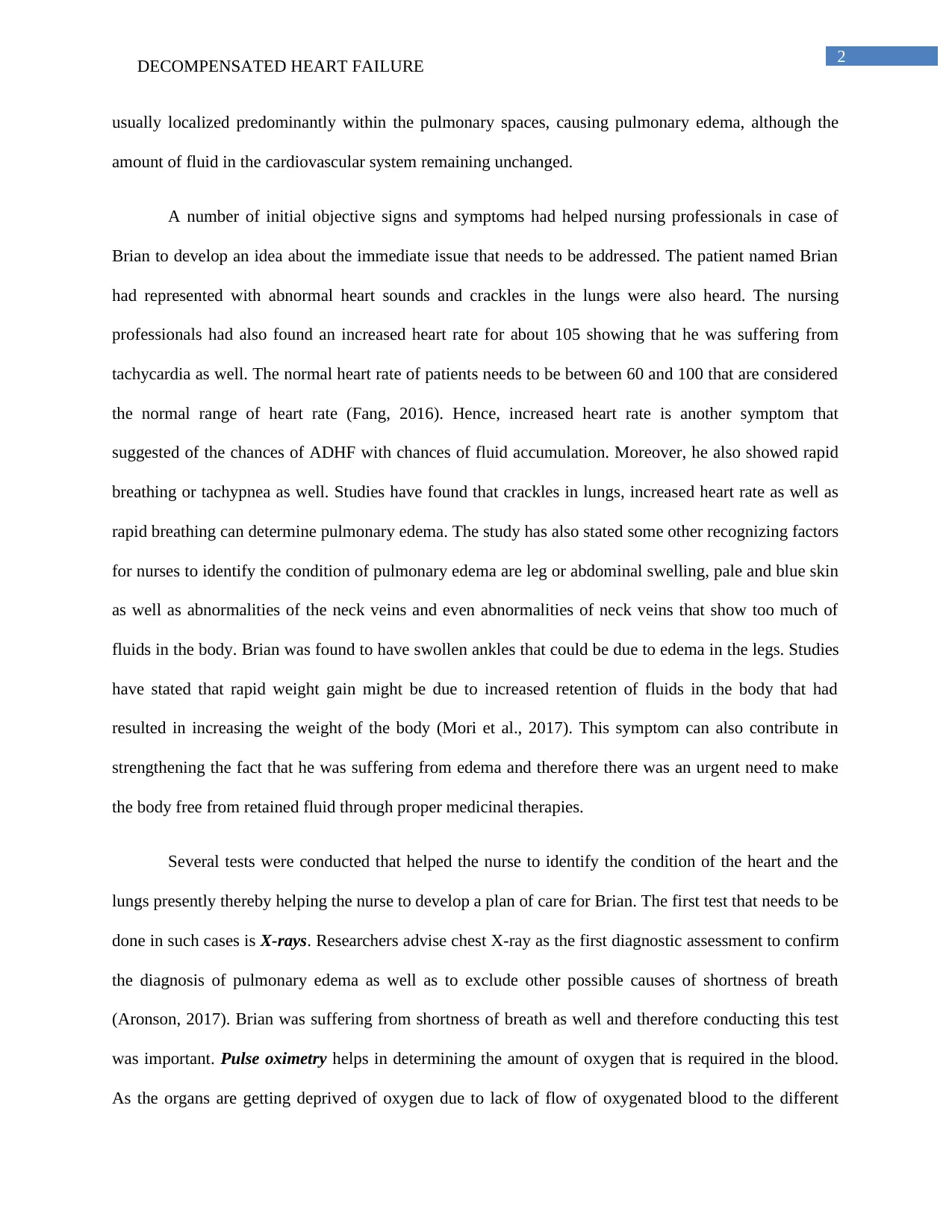
2
DECOMPENSATED HEART FAILURE
usually localized predominantly within the pulmonary spaces, causing pulmonary edema, although the
amount of fluid in the cardiovascular system remaining unchanged.
A number of initial objective signs and symptoms had helped nursing professionals in case of
Brian to develop an idea about the immediate issue that needs to be addressed. The patient named Brian
had represented with abnormal heart sounds and crackles in the lungs were also heard. The nursing
professionals had also found an increased heart rate for about 105 showing that he was suffering from
tachycardia as well. The normal heart rate of patients needs to be between 60 and 100 that are considered
the normal range of heart rate (Fang, 2016). Hence, increased heart rate is another symptom that
suggested of the chances of ADHF with chances of fluid accumulation. Moreover, he also showed rapid
breathing or tachypnea as well. Studies have found that crackles in lungs, increased heart rate as well as
rapid breathing can determine pulmonary edema. The study has also stated some other recognizing factors
for nurses to identify the condition of pulmonary edema are leg or abdominal swelling, pale and blue skin
as well as abnormalities of the neck veins and even abnormalities of neck veins that show too much of
fluids in the body. Brian was found to have swollen ankles that could be due to edema in the legs. Studies
have stated that rapid weight gain might be due to increased retention of fluids in the body that had
resulted in increasing the weight of the body (Mori et al., 2017). This symptom can also contribute in
strengthening the fact that he was suffering from edema and therefore there was an urgent need to make
the body free from retained fluid through proper medicinal therapies.
Several tests were conducted that helped the nurse to identify the condition of the heart and the
lungs presently thereby helping the nurse to develop a plan of care for Brian. The first test that needs to be
done in such cases is X-rays. Researchers advise chest X-ray as the first diagnostic assessment to confirm
the diagnosis of pulmonary edema as well as to exclude other possible causes of shortness of breath
(Aronson, 2017). Brian was suffering from shortness of breath as well and therefore conducting this test
was important. Pulse oximetry helps in determining the amount of oxygen that is required in the blood.
As the organs are getting deprived of oxygen due to lack of flow of oxygenated blood to the different
DECOMPENSATED HEART FAILURE
usually localized predominantly within the pulmonary spaces, causing pulmonary edema, although the
amount of fluid in the cardiovascular system remaining unchanged.
A number of initial objective signs and symptoms had helped nursing professionals in case of
Brian to develop an idea about the immediate issue that needs to be addressed. The patient named Brian
had represented with abnormal heart sounds and crackles in the lungs were also heard. The nursing
professionals had also found an increased heart rate for about 105 showing that he was suffering from
tachycardia as well. The normal heart rate of patients needs to be between 60 and 100 that are considered
the normal range of heart rate (Fang, 2016). Hence, increased heart rate is another symptom that
suggested of the chances of ADHF with chances of fluid accumulation. Moreover, he also showed rapid
breathing or tachypnea as well. Studies have found that crackles in lungs, increased heart rate as well as
rapid breathing can determine pulmonary edema. The study has also stated some other recognizing factors
for nurses to identify the condition of pulmonary edema are leg or abdominal swelling, pale and blue skin
as well as abnormalities of the neck veins and even abnormalities of neck veins that show too much of
fluids in the body. Brian was found to have swollen ankles that could be due to edema in the legs. Studies
have stated that rapid weight gain might be due to increased retention of fluids in the body that had
resulted in increasing the weight of the body (Mori et al., 2017). This symptom can also contribute in
strengthening the fact that he was suffering from edema and therefore there was an urgent need to make
the body free from retained fluid through proper medicinal therapies.
Several tests were conducted that helped the nurse to identify the condition of the heart and the
lungs presently thereby helping the nurse to develop a plan of care for Brian. The first test that needs to be
done in such cases is X-rays. Researchers advise chest X-ray as the first diagnostic assessment to confirm
the diagnosis of pulmonary edema as well as to exclude other possible causes of shortness of breath
(Aronson, 2017). Brian was suffering from shortness of breath as well and therefore conducting this test
was important. Pulse oximetry helps in determining the amount of oxygen that is required in the blood.
As the organs are getting deprived of oxygen due to lack of flow of oxygenated blood to the different
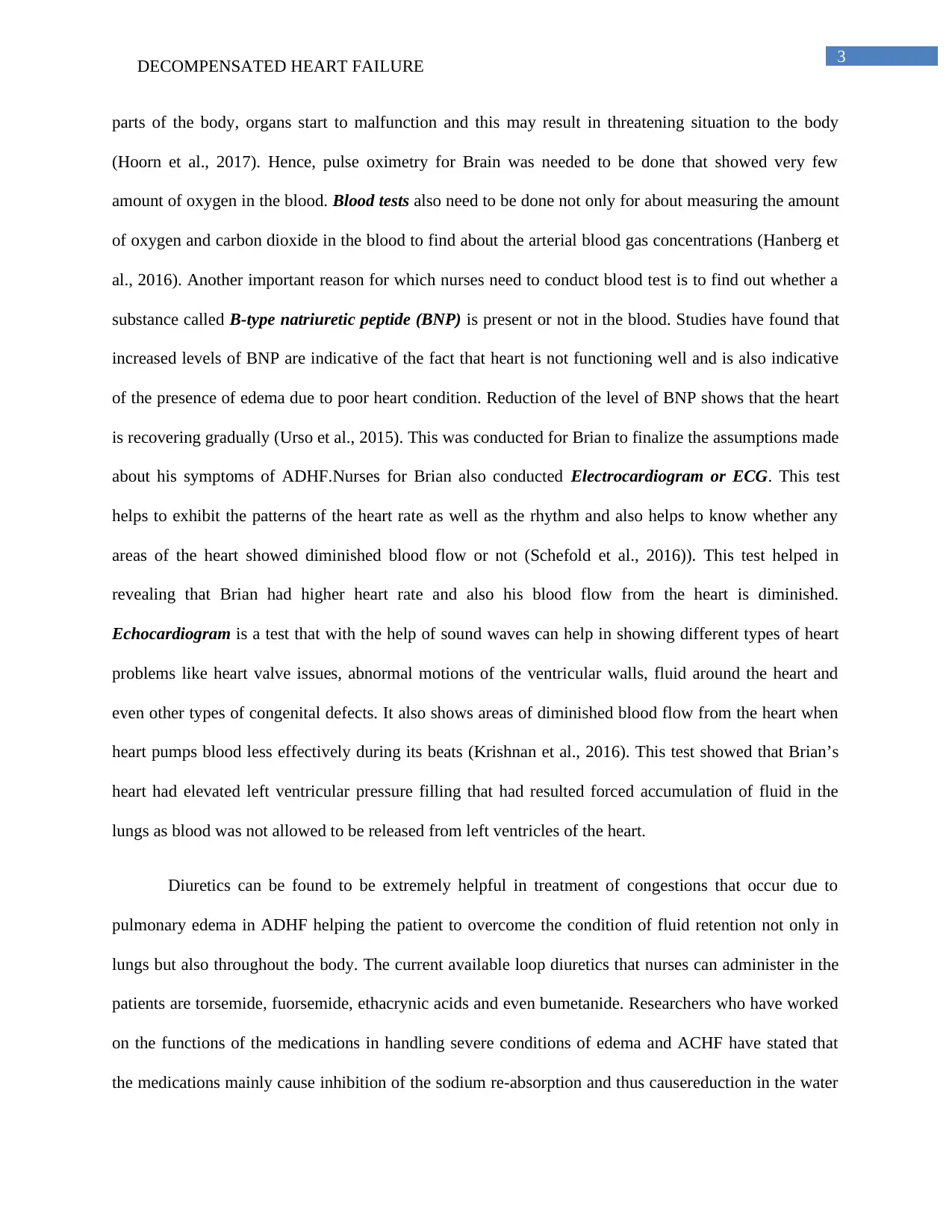
3
DECOMPENSATED HEART FAILURE
parts of the body, organs start to malfunction and this may result in threatening situation to the body
(Hoorn et al., 2017). Hence, pulse oximetry for Brain was needed to be done that showed very few
amount of oxygen in the blood. Blood tests also need to be done not only for about measuring the amount
of oxygen and carbon dioxide in the blood to find about the arterial blood gas concentrations (Hanberg et
al., 2016). Another important reason for which nurses need to conduct blood test is to find out whether a
substance called B-type natriuretic peptide (BNP) is present or not in the blood. Studies have found that
increased levels of BNP are indicative of the fact that heart is not functioning well and is also indicative
of the presence of edema due to poor heart condition. Reduction of the level of BNP shows that the heart
is recovering gradually (Urso et al., 2015). This was conducted for Brian to finalize the assumptions made
about his symptoms of ADHF.Nurses for Brian also conducted Electrocardiogram or ECG. This test
helps to exhibit the patterns of the heart rate as well as the rhythm and also helps to know whether any
areas of the heart showed diminished blood flow or not (Schefold et al., 2016)). This test helped in
revealing that Brian had higher heart rate and also his blood flow from the heart is diminished.
Echocardiogram is a test that with the help of sound waves can help in showing different types of heart
problems like heart valve issues, abnormal motions of the ventricular walls, fluid around the heart and
even other types of congenital defects. It also shows areas of diminished blood flow from the heart when
heart pumps blood less effectively during its beats (Krishnan et al., 2016). This test showed that Brian’s
heart had elevated left ventricular pressure filling that had resulted forced accumulation of fluid in the
lungs as blood was not allowed to be released from left ventricles of the heart.
Diuretics can be found to be extremely helpful in treatment of congestions that occur due to
pulmonary edema in ADHF helping the patient to overcome the condition of fluid retention not only in
lungs but also throughout the body. The current available loop diuretics that nurses can administer in the
patients are torsemide, fuorsemide, ethacrynic acids and even bumetanide. Researchers who have worked
on the functions of the medications in handling severe conditions of edema and ACHF have stated that
the medications mainly cause inhibition of the sodium re-absorption and thus causereduction in the water
DECOMPENSATED HEART FAILURE
parts of the body, organs start to malfunction and this may result in threatening situation to the body
(Hoorn et al., 2017). Hence, pulse oximetry for Brain was needed to be done that showed very few
amount of oxygen in the blood. Blood tests also need to be done not only for about measuring the amount
of oxygen and carbon dioxide in the blood to find about the arterial blood gas concentrations (Hanberg et
al., 2016). Another important reason for which nurses need to conduct blood test is to find out whether a
substance called B-type natriuretic peptide (BNP) is present or not in the blood. Studies have found that
increased levels of BNP are indicative of the fact that heart is not functioning well and is also indicative
of the presence of edema due to poor heart condition. Reduction of the level of BNP shows that the heart
is recovering gradually (Urso et al., 2015). This was conducted for Brian to finalize the assumptions made
about his symptoms of ADHF.Nurses for Brian also conducted Electrocardiogram or ECG. This test
helps to exhibit the patterns of the heart rate as well as the rhythm and also helps to know whether any
areas of the heart showed diminished blood flow or not (Schefold et al., 2016)). This test helped in
revealing that Brian had higher heart rate and also his blood flow from the heart is diminished.
Echocardiogram is a test that with the help of sound waves can help in showing different types of heart
problems like heart valve issues, abnormal motions of the ventricular walls, fluid around the heart and
even other types of congenital defects. It also shows areas of diminished blood flow from the heart when
heart pumps blood less effectively during its beats (Krishnan et al., 2016). This test showed that Brian’s
heart had elevated left ventricular pressure filling that had resulted forced accumulation of fluid in the
lungs as blood was not allowed to be released from left ventricles of the heart.
Diuretics can be found to be extremely helpful in treatment of congestions that occur due to
pulmonary edema in ADHF helping the patient to overcome the condition of fluid retention not only in
lungs but also throughout the body. The current available loop diuretics that nurses can administer in the
patients are torsemide, fuorsemide, ethacrynic acids and even bumetanide. Researchers who have worked
on the functions of the medications in handling severe conditions of edema and ACHF have stated that
the medications mainly cause inhibition of the sodium re-absorption and thus causereduction in the water
Secure Best Marks with AI Grader
Need help grading? Try our AI Grader for instant feedback on your assignments.
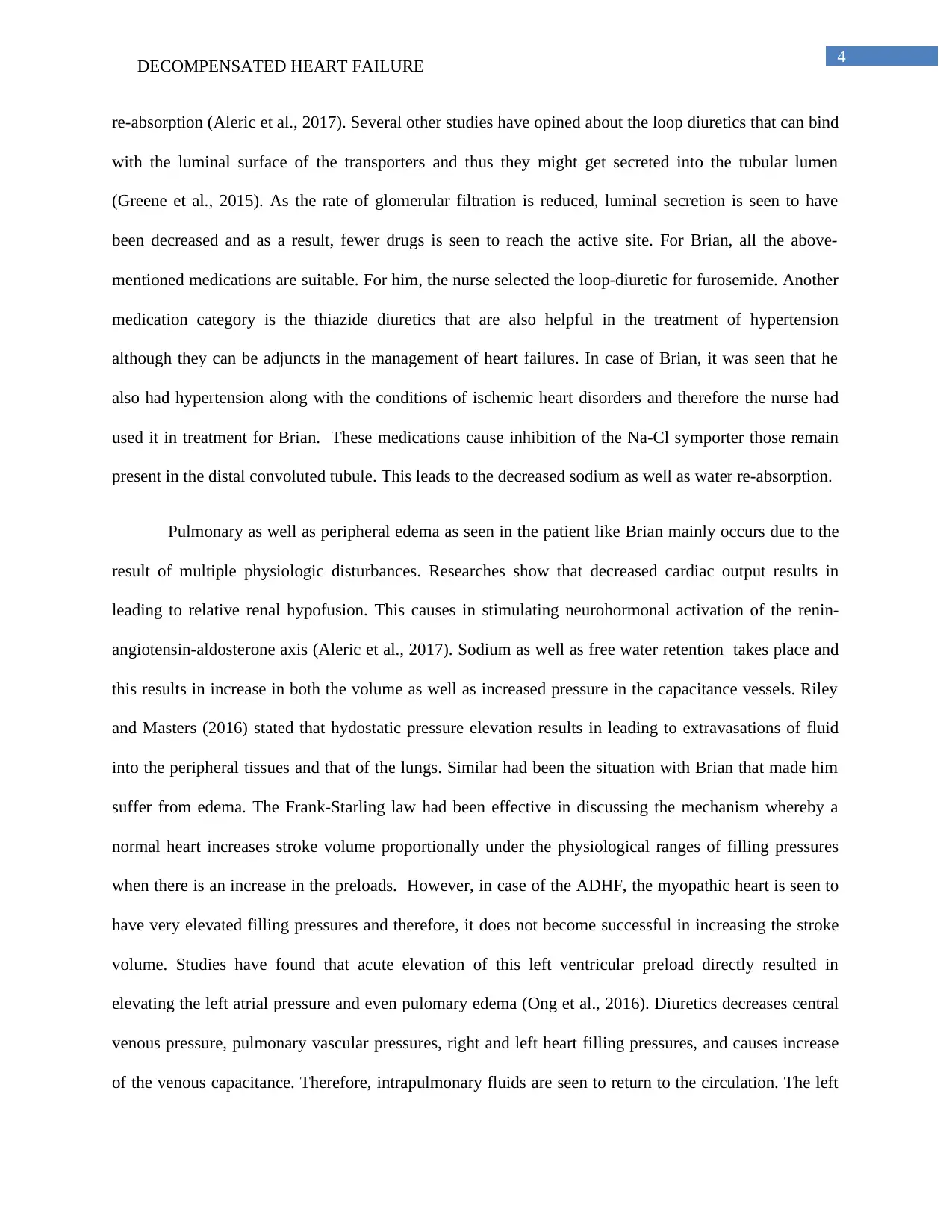
4
DECOMPENSATED HEART FAILURE
re-absorption (Aleric et al., 2017). Several other studies have opined about the loop diuretics that can bind
with the luminal surface of the transporters and thus they might get secreted into the tubular lumen
(Greene et al., 2015). As the rate of glomerular filtration is reduced, luminal secretion is seen to have
been decreased and as a result, fewer drugs is seen to reach the active site. For Brian, all the above-
mentioned medications are suitable. For him, the nurse selected the loop-diuretic for furosemide. Another
medication category is the thiazide diuretics that are also helpful in the treatment of hypertension
although they can be adjuncts in the management of heart failures. In case of Brian, it was seen that he
also had hypertension along with the conditions of ischemic heart disorders and therefore the nurse had
used it in treatment for Brian. These medications cause inhibition of the Na-Cl symporter those remain
present in the distal convoluted tubule. This leads to the decreased sodium as well as water re-absorption.
Pulmonary as well as peripheral edema as seen in the patient like Brian mainly occurs due to the
result of multiple physiologic disturbances. Researches show that decreased cardiac output results in
leading to relative renal hypofusion. This causes in stimulating neurohormonal activation of the renin-
angiotensin-aldosterone axis (Aleric et al., 2017). Sodium as well as free water retention takes place and
this results in increase in both the volume as well as increased pressure in the capacitance vessels. Riley
and Masters (2016) stated that hydostatic pressure elevation results in leading to extravasations of fluid
into the peripheral tissues and that of the lungs. Similar had been the situation with Brian that made him
suffer from edema. The Frank-Starling law had been effective in discussing the mechanism whereby a
normal heart increases stroke volume proportionally under the physiological ranges of filling pressures
when there is an increase in the preloads. However, in case of the ADHF, the myopathic heart is seen to
have very elevated filling pressures and therefore, it does not become successful in increasing the stroke
volume. Studies have found that acute elevation of this left ventricular preload directly resulted in
elevating the left atrial pressure and even pulomary edema (Ong et al., 2016). Diuretics decreases central
venous pressure, pulmonary vascular pressures, right and left heart filling pressures, and causes increase
of the venous capacitance. Therefore, intrapulmonary fluids are seen to return to the circulation. The left
DECOMPENSATED HEART FAILURE
re-absorption (Aleric et al., 2017). Several other studies have opined about the loop diuretics that can bind
with the luminal surface of the transporters and thus they might get secreted into the tubular lumen
(Greene et al., 2015). As the rate of glomerular filtration is reduced, luminal secretion is seen to have
been decreased and as a result, fewer drugs is seen to reach the active site. For Brian, all the above-
mentioned medications are suitable. For him, the nurse selected the loop-diuretic for furosemide. Another
medication category is the thiazide diuretics that are also helpful in the treatment of hypertension
although they can be adjuncts in the management of heart failures. In case of Brian, it was seen that he
also had hypertension along with the conditions of ischemic heart disorders and therefore the nurse had
used it in treatment for Brian. These medications cause inhibition of the Na-Cl symporter those remain
present in the distal convoluted tubule. This leads to the decreased sodium as well as water re-absorption.
Pulmonary as well as peripheral edema as seen in the patient like Brian mainly occurs due to the
result of multiple physiologic disturbances. Researches show that decreased cardiac output results in
leading to relative renal hypofusion. This causes in stimulating neurohormonal activation of the renin-
angiotensin-aldosterone axis (Aleric et al., 2017). Sodium as well as free water retention takes place and
this results in increase in both the volume as well as increased pressure in the capacitance vessels. Riley
and Masters (2016) stated that hydostatic pressure elevation results in leading to extravasations of fluid
into the peripheral tissues and that of the lungs. Similar had been the situation with Brian that made him
suffer from edema. The Frank-Starling law had been effective in discussing the mechanism whereby a
normal heart increases stroke volume proportionally under the physiological ranges of filling pressures
when there is an increase in the preloads. However, in case of the ADHF, the myopathic heart is seen to
have very elevated filling pressures and therefore, it does not become successful in increasing the stroke
volume. Studies have found that acute elevation of this left ventricular preload directly resulted in
elevating the left atrial pressure and even pulomary edema (Ong et al., 2016). Diuretics decreases central
venous pressure, pulmonary vascular pressures, right and left heart filling pressures, and causes increase
of the venous capacitance. Therefore, intrapulmonary fluids are seen to return to the circulation. The left
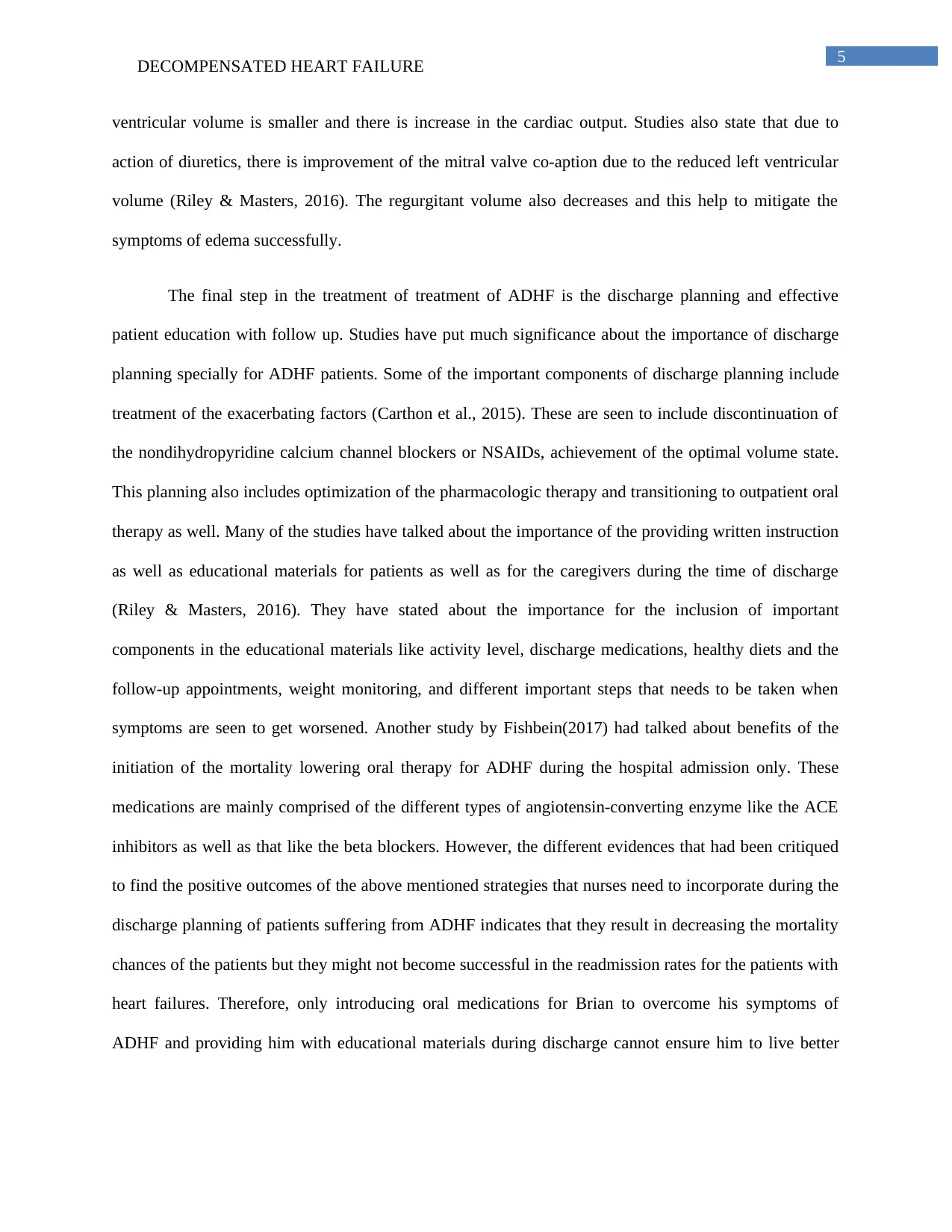
5
DECOMPENSATED HEART FAILURE
ventricular volume is smaller and there is increase in the cardiac output. Studies also state that due to
action of diuretics, there is improvement of the mitral valve co-aption due to the reduced left ventricular
volume (Riley & Masters, 2016). The regurgitant volume also decreases and this help to mitigate the
symptoms of edema successfully.
The final step in the treatment of treatment of ADHF is the discharge planning and effective
patient education with follow up. Studies have put much significance about the importance of discharge
planning specially for ADHF patients. Some of the important components of discharge planning include
treatment of the exacerbating factors (Carthon et al., 2015). These are seen to include discontinuation of
the nondihydropyridine calcium channel blockers or NSAIDs, achievement of the optimal volume state.
This planning also includes optimization of the pharmacologic therapy and transitioning to outpatient oral
therapy as well. Many of the studies have talked about the importance of the providing written instruction
as well as educational materials for patients as well as for the caregivers during the time of discharge
(Riley & Masters, 2016). They have stated about the importance for the inclusion of important
components in the educational materials like activity level, discharge medications, healthy diets and the
follow-up appointments, weight monitoring, and different important steps that needs to be taken when
symptoms are seen to get worsened. Another study by Fishbein(2017) had talked about benefits of the
initiation of the mortality lowering oral therapy for ADHF during the hospital admission only. These
medications are mainly comprised of the different types of angiotensin-converting enzyme like the ACE
inhibitors as well as that like the beta blockers. However, the different evidences that had been critiqued
to find the positive outcomes of the above mentioned strategies that nurses need to incorporate during the
discharge planning of patients suffering from ADHF indicates that they result in decreasing the mortality
chances of the patients but they might not become successful in the readmission rates for the patients with
heart failures. Therefore, only introducing oral medications for Brian to overcome his symptoms of
ADHF and providing him with educational materials during discharge cannot ensure him to live better
DECOMPENSATED HEART FAILURE
ventricular volume is smaller and there is increase in the cardiac output. Studies also state that due to
action of diuretics, there is improvement of the mitral valve co-aption due to the reduced left ventricular
volume (Riley & Masters, 2016). The regurgitant volume also decreases and this help to mitigate the
symptoms of edema successfully.
The final step in the treatment of treatment of ADHF is the discharge planning and effective
patient education with follow up. Studies have put much significance about the importance of discharge
planning specially for ADHF patients. Some of the important components of discharge planning include
treatment of the exacerbating factors (Carthon et al., 2015). These are seen to include discontinuation of
the nondihydropyridine calcium channel blockers or NSAIDs, achievement of the optimal volume state.
This planning also includes optimization of the pharmacologic therapy and transitioning to outpatient oral
therapy as well. Many of the studies have talked about the importance of the providing written instruction
as well as educational materials for patients as well as for the caregivers during the time of discharge
(Riley & Masters, 2016). They have stated about the importance for the inclusion of important
components in the educational materials like activity level, discharge medications, healthy diets and the
follow-up appointments, weight monitoring, and different important steps that needs to be taken when
symptoms are seen to get worsened. Another study by Fishbein(2017) had talked about benefits of the
initiation of the mortality lowering oral therapy for ADHF during the hospital admission only. These
medications are mainly comprised of the different types of angiotensin-converting enzyme like the ACE
inhibitors as well as that like the beta blockers. However, the different evidences that had been critiqued
to find the positive outcomes of the above mentioned strategies that nurses need to incorporate during the
discharge planning of patients suffering from ADHF indicates that they result in decreasing the mortality
chances of the patients but they might not become successful in the readmission rates for the patients with
heart failures. Therefore, only introducing oral medications for Brian to overcome his symptoms of
ADHF and providing him with educational materials during discharge cannot ensure him to live better
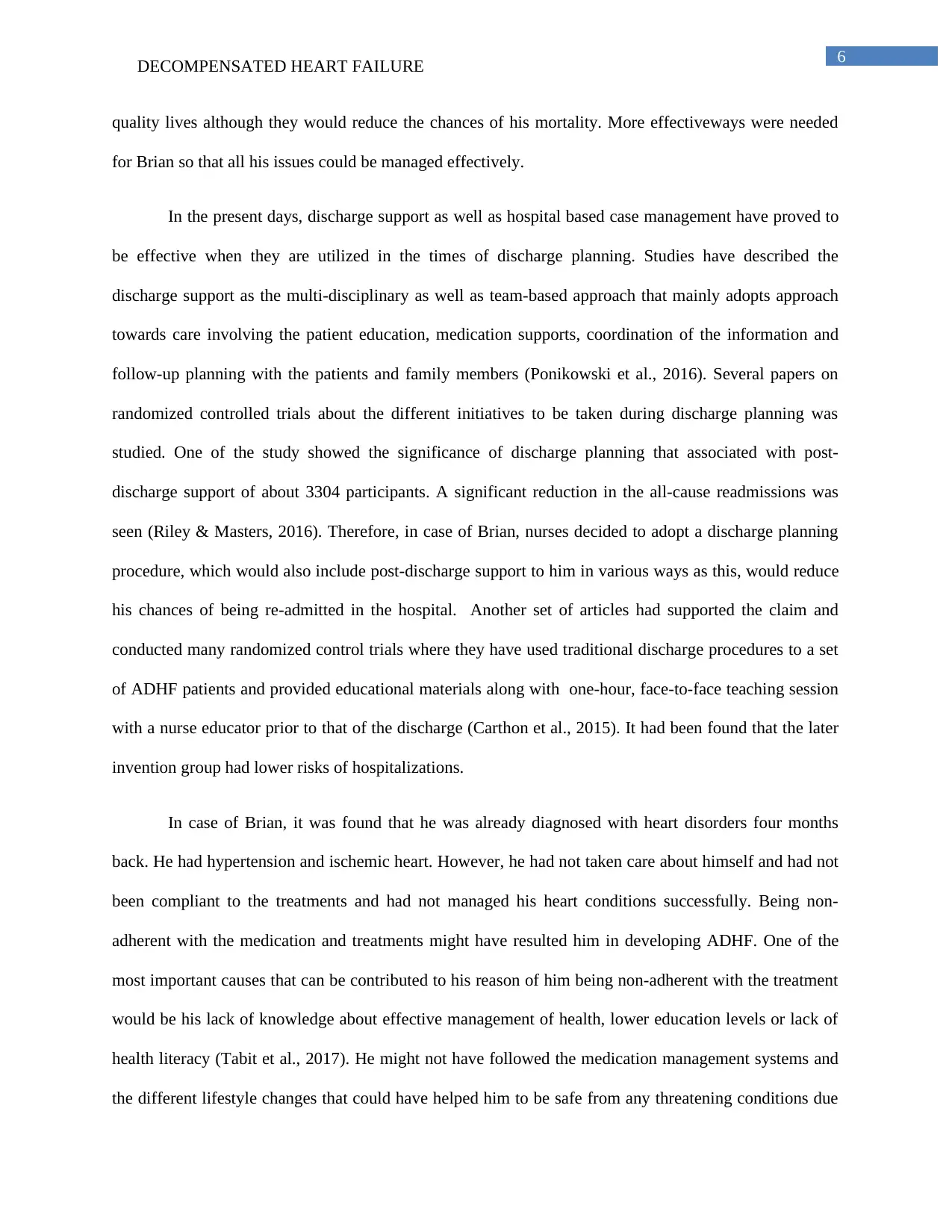
6
DECOMPENSATED HEART FAILURE
quality lives although they would reduce the chances of his mortality. More effectiveways were needed
for Brian so that all his issues could be managed effectively.
In the present days, discharge support as well as hospital based case management have proved to
be effective when they are utilized in the times of discharge planning. Studies have described the
discharge support as the multi-disciplinary as well as team-based approach that mainly adopts approach
towards care involving the patient education, medication supports, coordination of the information and
follow-up planning with the patients and family members (Ponikowski et al., 2016). Several papers on
randomized controlled trials about the different initiatives to be taken during discharge planning was
studied. One of the study showed the significance of discharge planning that associated with post-
discharge support of about 3304 participants. A significant reduction in the all-cause readmissions was
seen (Riley & Masters, 2016). Therefore, in case of Brian, nurses decided to adopt a discharge planning
procedure, which would also include post-discharge support to him in various ways as this, would reduce
his chances of being re-admitted in the hospital. Another set of articles had supported the claim and
conducted many randomized control trials where they have used traditional discharge procedures to a set
of ADHF patients and provided educational materials along with one-hour, face-to-face teaching session
with a nurse educator prior to that of the discharge (Carthon et al., 2015). It had been found that the later
invention group had lower risks of hospitalizations.
In case of Brian, it was found that he was already diagnosed with heart disorders four months
back. He had hypertension and ischemic heart. However, he had not taken care about himself and had not
been compliant to the treatments and had not managed his heart conditions successfully. Being non-
adherent with the medication and treatments might have resulted him in developing ADHF. One of the
most important causes that can be contributed to his reason of him being non-adherent with the treatment
would be his lack of knowledge about effective management of health, lower education levels or lack of
health literacy (Tabit et al., 2017). He might not have followed the medication management systems and
the different lifestyle changes that could have helped him to be safe from any threatening conditions due
DECOMPENSATED HEART FAILURE
quality lives although they would reduce the chances of his mortality. More effectiveways were needed
for Brian so that all his issues could be managed effectively.
In the present days, discharge support as well as hospital based case management have proved to
be effective when they are utilized in the times of discharge planning. Studies have described the
discharge support as the multi-disciplinary as well as team-based approach that mainly adopts approach
towards care involving the patient education, medication supports, coordination of the information and
follow-up planning with the patients and family members (Ponikowski et al., 2016). Several papers on
randomized controlled trials about the different initiatives to be taken during discharge planning was
studied. One of the study showed the significance of discharge planning that associated with post-
discharge support of about 3304 participants. A significant reduction in the all-cause readmissions was
seen (Riley & Masters, 2016). Therefore, in case of Brian, nurses decided to adopt a discharge planning
procedure, which would also include post-discharge support to him in various ways as this, would reduce
his chances of being re-admitted in the hospital. Another set of articles had supported the claim and
conducted many randomized control trials where they have used traditional discharge procedures to a set
of ADHF patients and provided educational materials along with one-hour, face-to-face teaching session
with a nurse educator prior to that of the discharge (Carthon et al., 2015). It had been found that the later
invention group had lower risks of hospitalizations.
In case of Brian, it was found that he was already diagnosed with heart disorders four months
back. He had hypertension and ischemic heart. However, he had not taken care about himself and had not
been compliant to the treatments and had not managed his heart conditions successfully. Being non-
adherent with the medication and treatments might have resulted him in developing ADHF. One of the
most important causes that can be contributed to his reason of him being non-adherent with the treatment
would be his lack of knowledge about effective management of health, lower education levels or lack of
health literacy (Tabit et al., 2017). He might not have followed the medication management systems and
the different lifestyle changes that could have helped him to be safe from any threatening conditions due
Paraphrase This Document
Need a fresh take? Get an instant paraphrase of this document with our AI Paraphraser
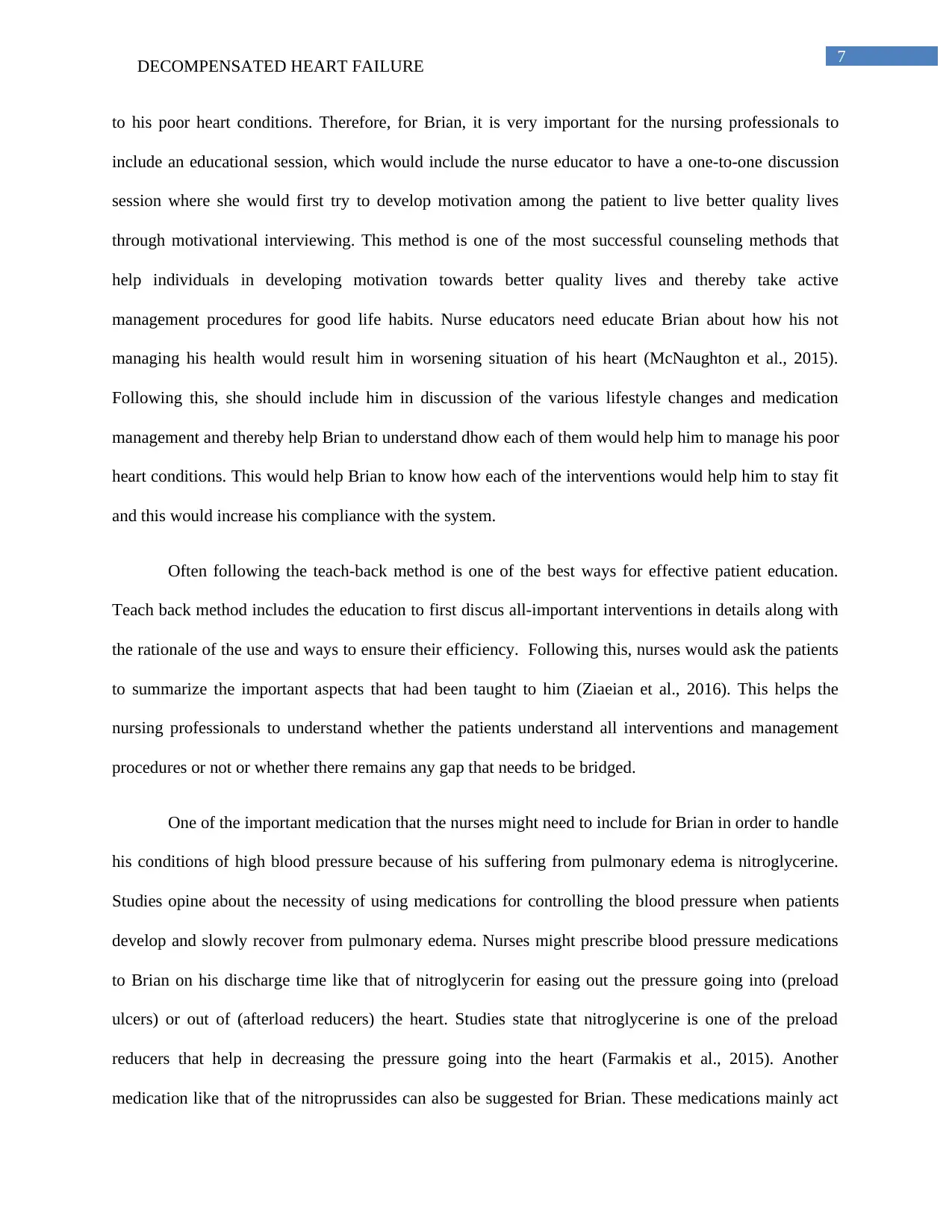
7
DECOMPENSATED HEART FAILURE
to his poor heart conditions. Therefore, for Brian, it is very important for the nursing professionals to
include an educational session, which would include the nurse educator to have a one-to-one discussion
session where she would first try to develop motivation among the patient to live better quality lives
through motivational interviewing. This method is one of the most successful counseling methods that
help individuals in developing motivation towards better quality lives and thereby take active
management procedures for good life habits. Nurse educators need educate Brian about how his not
managing his health would result him in worsening situation of his heart (McNaughton et al., 2015).
Following this, she should include him in discussion of the various lifestyle changes and medication
management and thereby help Brian to understand dhow each of them would help him to manage his poor
heart conditions. This would help Brian to know how each of the interventions would help him to stay fit
and this would increase his compliance with the system.
Often following the teach-back method is one of the best ways for effective patient education.
Teach back method includes the education to first discus all-important interventions in details along with
the rationale of the use and ways to ensure their efficiency. Following this, nurses would ask the patients
to summarize the important aspects that had been taught to him (Ziaeian et al., 2016). This helps the
nursing professionals to understand whether the patients understand all interventions and management
procedures or not or whether there remains any gap that needs to be bridged.
One of the important medication that the nurses might need to include for Brian in order to handle
his conditions of high blood pressure because of his suffering from pulmonary edema is nitroglycerine.
Studies opine about the necessity of using medications for controlling the blood pressure when patients
develop and slowly recover from pulmonary edema. Nurses might prescribe blood pressure medications
to Brian on his discharge time like that of nitroglycerin for easing out the pressure going into (preload
ulcers) or out of (afterload reducers) the heart. Studies state that nitroglycerine is one of the preload
reducers that help in decreasing the pressure going into the heart (Farmakis et al., 2015). Another
medication like that of the nitroprussides can also be suggested for Brian. These medications mainly act
DECOMPENSATED HEART FAILURE
to his poor heart conditions. Therefore, for Brian, it is very important for the nursing professionals to
include an educational session, which would include the nurse educator to have a one-to-one discussion
session where she would first try to develop motivation among the patient to live better quality lives
through motivational interviewing. This method is one of the most successful counseling methods that
help individuals in developing motivation towards better quality lives and thereby take active
management procedures for good life habits. Nurse educators need educate Brian about how his not
managing his health would result him in worsening situation of his heart (McNaughton et al., 2015).
Following this, she should include him in discussion of the various lifestyle changes and medication
management and thereby help Brian to understand dhow each of them would help him to manage his poor
heart conditions. This would help Brian to know how each of the interventions would help him to stay fit
and this would increase his compliance with the system.
Often following the teach-back method is one of the best ways for effective patient education.
Teach back method includes the education to first discus all-important interventions in details along with
the rationale of the use and ways to ensure their efficiency. Following this, nurses would ask the patients
to summarize the important aspects that had been taught to him (Ziaeian et al., 2016). This helps the
nursing professionals to understand whether the patients understand all interventions and management
procedures or not or whether there remains any gap that needs to be bridged.
One of the important medication that the nurses might need to include for Brian in order to handle
his conditions of high blood pressure because of his suffering from pulmonary edema is nitroglycerine.
Studies opine about the necessity of using medications for controlling the blood pressure when patients
develop and slowly recover from pulmonary edema. Nurses might prescribe blood pressure medications
to Brian on his discharge time like that of nitroglycerin for easing out the pressure going into (preload
ulcers) or out of (afterload reducers) the heart. Studies state that nitroglycerine is one of the preload
reducers that help in decreasing the pressure going into the heart (Farmakis et al., 2015). Another
medication like that of the nitroprussides can also be suggested for Brian. These medications mainly act
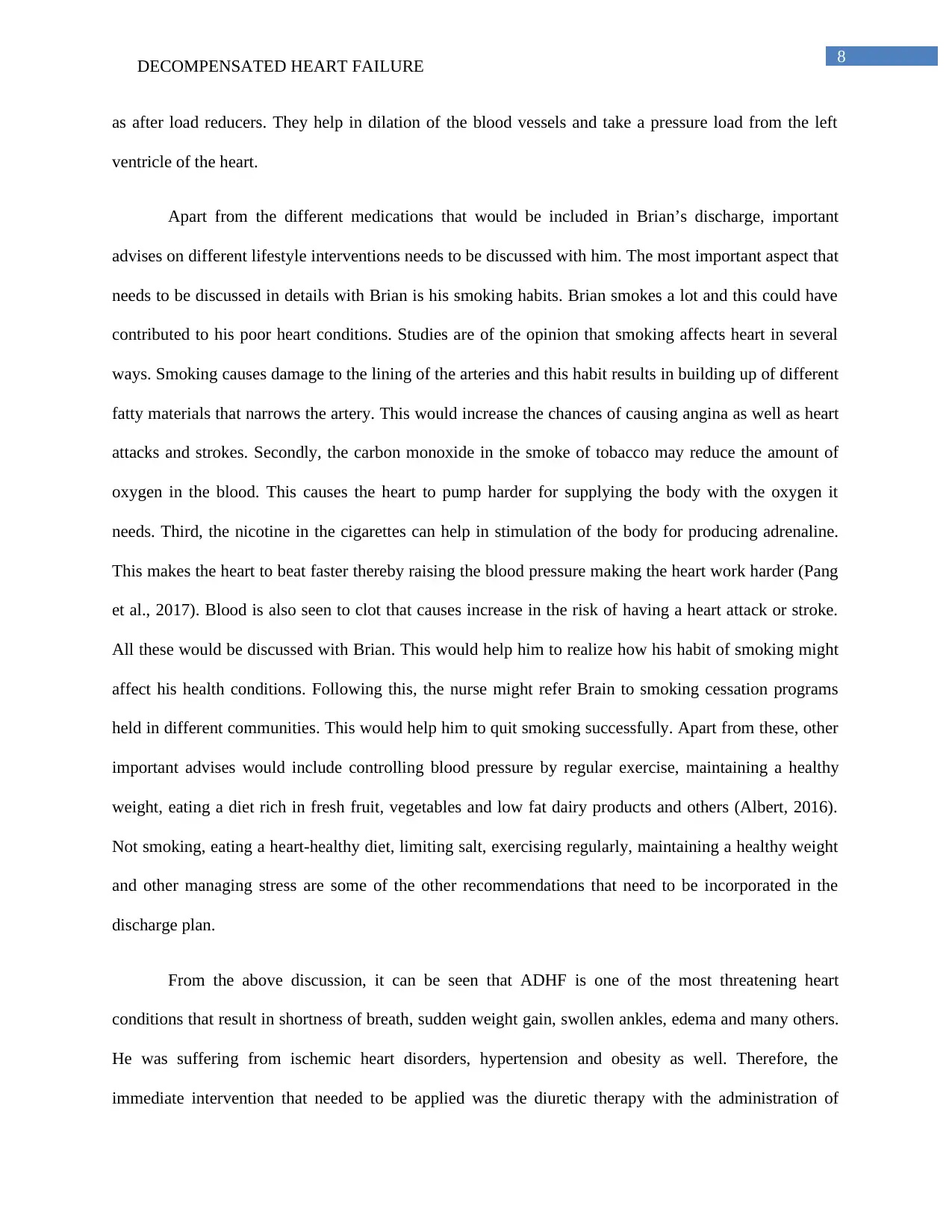
8
DECOMPENSATED HEART FAILURE
as after load reducers. They help in dilation of the blood vessels and take a pressure load from the left
ventricle of the heart.
Apart from the different medications that would be included in Brian’s discharge, important
advises on different lifestyle interventions needs to be discussed with him. The most important aspect that
needs to be discussed in details with Brian is his smoking habits. Brian smokes a lot and this could have
contributed to his poor heart conditions. Studies are of the opinion that smoking affects heart in several
ways. Smoking causes damage to the lining of the arteries and this habit results in building up of different
fatty materials that narrows the artery. This would increase the chances of causing angina as well as heart
attacks and strokes. Secondly, the carbon monoxide in the smoke of tobacco may reduce the amount of
oxygen in the blood. This causes the heart to pump harder for supplying the body with the oxygen it
needs. Third, the nicotine in the cigarettes can help in stimulation of the body for producing adrenaline.
This makes the heart to beat faster thereby raising the blood pressure making the heart work harder (Pang
et al., 2017). Blood is also seen to clot that causes increase in the risk of having a heart attack or stroke.
All these would be discussed with Brian. This would help him to realize how his habit of smoking might
affect his health conditions. Following this, the nurse might refer Brain to smoking cessation programs
held in different communities. This would help him to quit smoking successfully. Apart from these, other
important advises would include controlling blood pressure by regular exercise, maintaining a healthy
weight, eating a diet rich in fresh fruit, vegetables and low fat dairy products and others (Albert, 2016).
Not smoking, eating a heart-healthy diet, limiting salt, exercising regularly, maintaining a healthy weight
and other managing stress are some of the other recommendations that need to be incorporated in the
discharge plan.
From the above discussion, it can be seen that ADHF is one of the most threatening heart
conditions that result in shortness of breath, sudden weight gain, swollen ankles, edema and many others.
He was suffering from ischemic heart disorders, hypertension and obesity as well. Therefore, the
immediate intervention that needed to be applied was the diuretic therapy with the administration of
DECOMPENSATED HEART FAILURE
as after load reducers. They help in dilation of the blood vessels and take a pressure load from the left
ventricle of the heart.
Apart from the different medications that would be included in Brian’s discharge, important
advises on different lifestyle interventions needs to be discussed with him. The most important aspect that
needs to be discussed in details with Brian is his smoking habits. Brian smokes a lot and this could have
contributed to his poor heart conditions. Studies are of the opinion that smoking affects heart in several
ways. Smoking causes damage to the lining of the arteries and this habit results in building up of different
fatty materials that narrows the artery. This would increase the chances of causing angina as well as heart
attacks and strokes. Secondly, the carbon monoxide in the smoke of tobacco may reduce the amount of
oxygen in the blood. This causes the heart to pump harder for supplying the body with the oxygen it
needs. Third, the nicotine in the cigarettes can help in stimulation of the body for producing adrenaline.
This makes the heart to beat faster thereby raising the blood pressure making the heart work harder (Pang
et al., 2017). Blood is also seen to clot that causes increase in the risk of having a heart attack or stroke.
All these would be discussed with Brian. This would help him to realize how his habit of smoking might
affect his health conditions. Following this, the nurse might refer Brain to smoking cessation programs
held in different communities. This would help him to quit smoking successfully. Apart from these, other
important advises would include controlling blood pressure by regular exercise, maintaining a healthy
weight, eating a diet rich in fresh fruit, vegetables and low fat dairy products and others (Albert, 2016).
Not smoking, eating a heart-healthy diet, limiting salt, exercising regularly, maintaining a healthy weight
and other managing stress are some of the other recommendations that need to be incorporated in the
discharge plan.
From the above discussion, it can be seen that ADHF is one of the most threatening heart
conditions that result in shortness of breath, sudden weight gain, swollen ankles, edema and many others.
He was suffering from ischemic heart disorders, hypertension and obesity as well. Therefore, the
immediate intervention that needed to be applied was the diuretic therapy with the administration of
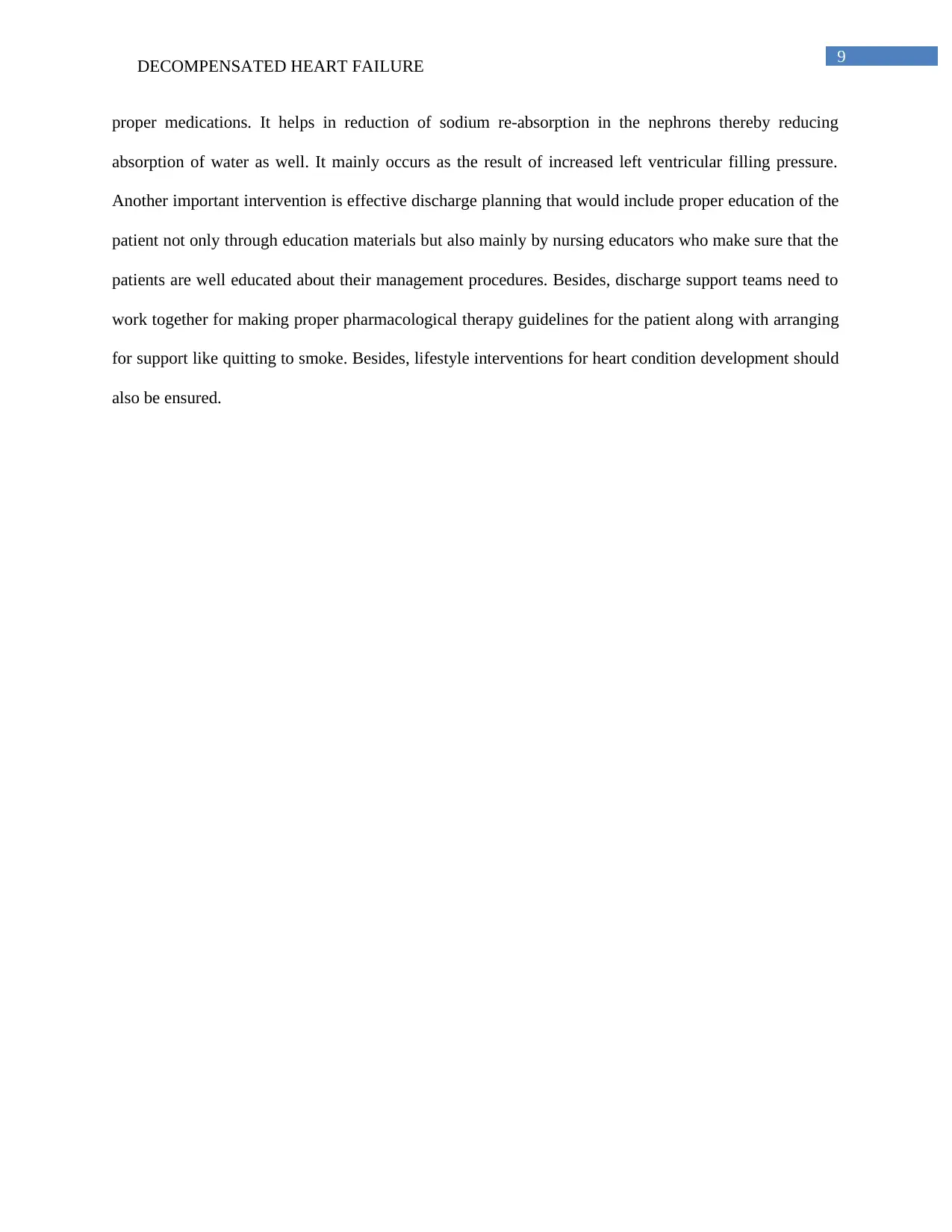
9
DECOMPENSATED HEART FAILURE
proper medications. It helps in reduction of sodium re-absorption in the nephrons thereby reducing
absorption of water as well. It mainly occurs as the result of increased left ventricular filling pressure.
Another important intervention is effective discharge planning that would include proper education of the
patient not only through education materials but also mainly by nursing educators who make sure that the
patients are well educated about their management procedures. Besides, discharge support teams need to
work together for making proper pharmacological therapy guidelines for the patient along with arranging
for support like quitting to smoke. Besides, lifestyle interventions for heart condition development should
also be ensured.
DECOMPENSATED HEART FAILURE
proper medications. It helps in reduction of sodium re-absorption in the nephrons thereby reducing
absorption of water as well. It mainly occurs as the result of increased left ventricular filling pressure.
Another important intervention is effective discharge planning that would include proper education of the
patient not only through education materials but also mainly by nursing educators who make sure that the
patients are well educated about their management procedures. Besides, discharge support teams need to
work together for making proper pharmacological therapy guidelines for the patient along with arranging
for support like quitting to smoke. Besides, lifestyle interventions for heart condition development should
also be ensured.
Secure Best Marks with AI Grader
Need help grading? Try our AI Grader for instant feedback on your assignments.

10
DECOMPENSATED HEART FAILURE
References:
Albert, N. M. (2016). A systematic review of transitional-care strategies to reduce rehospitalization in
patients with heart failure. Heart & Lung, 45(2), 100-113.
Aleric, I., Katalinic, D., & Krpan, M. (2017). Cardiopulmonary interactions with consecutive pulmonary
abnormalities in patients with chronic heart failure. Acta Clinica Croatica, 56(3), 526-536.
Aronson, D. (2017). The complexity of diuretic resistance. European journal of heart failure, 19(8),
1023-1026.
Bramblett, T., Teleb, M., Albaghdadi, A., Agrawal, H., & Mukherjee, D. (2017). Heart Failure with
Preserved Ejection Fraction: Entresto a Possible Option. Cardiovascular & Haematological
Disorders-Drug Targets (Formerly Current Drug Targets-Cardiovascular & Hematological
Disorders), 17(2), 80-85.
Carthon, J. M. B., Lasater, K. B., Sloane, D. M., & Kutney-Lee, A. (2015). The quality of hospital work
environments and missed nursing care is linked to heart failure readmissions: a cross-sectional
study of US hospitals. BMJ Qual Saf, 24(4), 255-263.
Fang, J. C. (2016). Heart failure with preserved ejection fraction: a kidney disorder?. Circulation, 134(6),
435-437.
Farmakis, D., Parissis, J., Lekakis, J., & Filippatos, G. (2015). Acute heart failure: epidemiology, risk
factors, and prevention. Revista Española de Cardiología (English Edition), 68(3), 245-248.
Fishbein, D. (2017). Acute Decompensated Heart Failure: Treatment with Guideline Directed Medical
Therapy and Discharge Planning. In Heart Failure (pp. 285-308). Springer, London.
DECOMPENSATED HEART FAILURE
References:
Albert, N. M. (2016). A systematic review of transitional-care strategies to reduce rehospitalization in
patients with heart failure. Heart & Lung, 45(2), 100-113.
Aleric, I., Katalinic, D., & Krpan, M. (2017). Cardiopulmonary interactions with consecutive pulmonary
abnormalities in patients with chronic heart failure. Acta Clinica Croatica, 56(3), 526-536.
Aronson, D. (2017). The complexity of diuretic resistance. European journal of heart failure, 19(8),
1023-1026.
Bramblett, T., Teleb, M., Albaghdadi, A., Agrawal, H., & Mukherjee, D. (2017). Heart Failure with
Preserved Ejection Fraction: Entresto a Possible Option. Cardiovascular & Haematological
Disorders-Drug Targets (Formerly Current Drug Targets-Cardiovascular & Hematological
Disorders), 17(2), 80-85.
Carthon, J. M. B., Lasater, K. B., Sloane, D. M., & Kutney-Lee, A. (2015). The quality of hospital work
environments and missed nursing care is linked to heart failure readmissions: a cross-sectional
study of US hospitals. BMJ Qual Saf, 24(4), 255-263.
Fang, J. C. (2016). Heart failure with preserved ejection fraction: a kidney disorder?. Circulation, 134(6),
435-437.
Farmakis, D., Parissis, J., Lekakis, J., & Filippatos, G. (2015). Acute heart failure: epidemiology, risk
factors, and prevention. Revista Española de Cardiología (English Edition), 68(3), 245-248.
Fishbein, D. (2017). Acute Decompensated Heart Failure: Treatment with Guideline Directed Medical
Therapy and Discharge Planning. In Heart Failure (pp. 285-308). Springer, London.

11
DECOMPENSATED HEART FAILURE
Greene, S. J., Fonarow, G. C., Vaduganathan, M., Khan, S. S., Butler, J., & Gheorghiade, M. (2015). The
vulnerable phase after hospitalization for heart failure. Nature Reviews Cardiology, 12(4), 220.
Hanberg, J. S., Rao, V., Ter Maaten, J. M., Laur, O., Brisco, M. A., Perry Wilson, F., ... & Ahmad, T.
(2016). Hypochloremia and diuretic resistance in heart failure: mechanistic insights. Circulation:
Heart Failure, 9(8), e003180.
Hoorn, E. J., & Ellison, D. H. (2017). Diuretic resistance. American Journal of Kidney Diseases, 69(1),
136-142.
Jha, V. K., Padmaprakash, K. V., & Pandey, R. (2018). Diuretic strategies in medical disorders. Current
Medical Issues, 16(2), 60.
Krishnan, D. K., Pawlaczyk, B., McCullough, P. A., Enright, S., Kunadi, A., & Vanhecke, T. E. (2016).
Point-of-care, ultraportable echocardiography predicts diuretic response in patients admitted with
acute decompensated heart failure. Clinical Medicine Insights: Cardiology, 10, CMC-S38896.
McNaughton, C. D., Cawthon, C., Kripalani, S., Liu, D., Storrow, A. B., & Roumie, C. L. (2015). Health
literacy and mortality: a cohort study of patients hospitalized for acute heart failure. Journal of
the American Heart Association, 4(5), e001799.
Mori, T., Ohsaki, Y., Oba‐Yabana, I., & Ito, S. (2017). Diuretic usage for protection against end‐organ
damage in liver cirrhosis and heart failure. Hepatology Research, 47(1), 11-22.
Ong, M. K., Romano, P. S., Edgington, S., Aronow, H. U., Auerbach, A. D., Black, J. T., ... & Ganiats, T.
G. (2016). Effectiveness of remote patient monitoring after discharge of hospitalized patients
with heart failure: the better effectiveness after transition–heart failure (BEAT-HF) randomized
clinical trial. JAMA internal medicine, 176(3), 310-318.
DECOMPENSATED HEART FAILURE
Greene, S. J., Fonarow, G. C., Vaduganathan, M., Khan, S. S., Butler, J., & Gheorghiade, M. (2015). The
vulnerable phase after hospitalization for heart failure. Nature Reviews Cardiology, 12(4), 220.
Hanberg, J. S., Rao, V., Ter Maaten, J. M., Laur, O., Brisco, M. A., Perry Wilson, F., ... & Ahmad, T.
(2016). Hypochloremia and diuretic resistance in heart failure: mechanistic insights. Circulation:
Heart Failure, 9(8), e003180.
Hoorn, E. J., & Ellison, D. H. (2017). Diuretic resistance. American Journal of Kidney Diseases, 69(1),
136-142.
Jha, V. K., Padmaprakash, K. V., & Pandey, R. (2018). Diuretic strategies in medical disorders. Current
Medical Issues, 16(2), 60.
Krishnan, D. K., Pawlaczyk, B., McCullough, P. A., Enright, S., Kunadi, A., & Vanhecke, T. E. (2016).
Point-of-care, ultraportable echocardiography predicts diuretic response in patients admitted with
acute decompensated heart failure. Clinical Medicine Insights: Cardiology, 10, CMC-S38896.
McNaughton, C. D., Cawthon, C., Kripalani, S., Liu, D., Storrow, A. B., & Roumie, C. L. (2015). Health
literacy and mortality: a cohort study of patients hospitalized for acute heart failure. Journal of
the American Heart Association, 4(5), e001799.
Mori, T., Ohsaki, Y., Oba‐Yabana, I., & Ito, S. (2017). Diuretic usage for protection against end‐organ
damage in liver cirrhosis and heart failure. Hepatology Research, 47(1), 11-22.
Ong, M. K., Romano, P. S., Edgington, S., Aronow, H. U., Auerbach, A. D., Black, J. T., ... & Ganiats, T.
G. (2016). Effectiveness of remote patient monitoring after discharge of hospitalized patients
with heart failure: the better effectiveness after transition–heart failure (BEAT-HF) randomized
clinical trial. JAMA internal medicine, 176(3), 310-318.

12
DECOMPENSATED HEART FAILURE
Pang, P. S., Collins, S. P., Miró, Ò., Bueno, H., Diercks, D. B., Di Somma, S., ... & Levy, P. D. (2017).
Editor’s Choice-The role of the emergency department in the management of acute heart failure:
An international perspective on education and research. European Heart Journal: Acute
Cardiovascular Care, 6(5), 421-429.
Ponikowski, P., Voors, A. A., Anker, S. D., Bueno, H., Cleland, J. G., Coats, A. J., ... & Jessup, M.
(2016). 2016 ESC Guidelines for the diagnosis and treatment of acute and chronic heart failure:
The Task Force for the diagnosis and treatment of acute and chronic heart failure of the European
Society of Cardiology (ESC). Developed with the special contribution of the Heart Failure
Association (HFA) of the ESC. European journal of heart failure, 18(8), 891-975.
Qavi, A. H., Kamal, R., & Schrier, R. W. (2015). Clinical use of diuretics in heart failure, cirrhosis, and
nephrotic syndrome. International journal of nephrology, 2015.
Riley, J. P., & Masters, J. (2016). Practical multidisciplinary approaches to heart failure management for
improved patient outcome. European Heart Journal Supplements, 18(suppl_G), G43-G52.
Schefold, J. C., Filippatos, G., Hasenfuss, G., Anker, S. D., & Von Haehling, S. (2016). Heart failure and
kidney dysfunction: epidemiology, mechanisms and management. Nature Reviews
Nephrology, 12(10), 610.
Tabit, C. E., Coplan, M. J., Spencer, K. T., Alcain, C. F., Spiegel, T., Vohra, A. S., ... & Sanghani, R. M.
(2017). Cardiology consultation in the emergency department reduces re-hospitalizations for low-
socioeconomic patients with acute decompensated heart failure. The American journal of
medicine, 130(9), 1112-e17.
Urso, C., Brucculeri, S., & Caimi, G. (2015). Acid–base and electrolyte abnormalities in heart failure:
pathophysiology and implications. Heart failure reviews, 20(4), 493-503.
DECOMPENSATED HEART FAILURE
Pang, P. S., Collins, S. P., Miró, Ò., Bueno, H., Diercks, D. B., Di Somma, S., ... & Levy, P. D. (2017).
Editor’s Choice-The role of the emergency department in the management of acute heart failure:
An international perspective on education and research. European Heart Journal: Acute
Cardiovascular Care, 6(5), 421-429.
Ponikowski, P., Voors, A. A., Anker, S. D., Bueno, H., Cleland, J. G., Coats, A. J., ... & Jessup, M.
(2016). 2016 ESC Guidelines for the diagnosis and treatment of acute and chronic heart failure:
The Task Force for the diagnosis and treatment of acute and chronic heart failure of the European
Society of Cardiology (ESC). Developed with the special contribution of the Heart Failure
Association (HFA) of the ESC. European journal of heart failure, 18(8), 891-975.
Qavi, A. H., Kamal, R., & Schrier, R. W. (2015). Clinical use of diuretics in heart failure, cirrhosis, and
nephrotic syndrome. International journal of nephrology, 2015.
Riley, J. P., & Masters, J. (2016). Practical multidisciplinary approaches to heart failure management for
improved patient outcome. European Heart Journal Supplements, 18(suppl_G), G43-G52.
Schefold, J. C., Filippatos, G., Hasenfuss, G., Anker, S. D., & Von Haehling, S. (2016). Heart failure and
kidney dysfunction: epidemiology, mechanisms and management. Nature Reviews
Nephrology, 12(10), 610.
Tabit, C. E., Coplan, M. J., Spencer, K. T., Alcain, C. F., Spiegel, T., Vohra, A. S., ... & Sanghani, R. M.
(2017). Cardiology consultation in the emergency department reduces re-hospitalizations for low-
socioeconomic patients with acute decompensated heart failure. The American journal of
medicine, 130(9), 1112-e17.
Urso, C., Brucculeri, S., & Caimi, G. (2015). Acid–base and electrolyte abnormalities in heart failure:
pathophysiology and implications. Heart failure reviews, 20(4), 493-503.
Paraphrase This Document
Need a fresh take? Get an instant paraphrase of this document with our AI Paraphraser

13
DECOMPENSATED HEART FAILURE
Ziaeian, B., & Fonarow, G. C. (2016). The prevention of hospital readmissions in heart failure. Progress
in cardiovascular diseases, 58(4), 379-385.
DECOMPENSATED HEART FAILURE
Ziaeian, B., & Fonarow, G. C. (2016). The prevention of hospital readmissions in heart failure. Progress
in cardiovascular diseases, 58(4), 379-385.
1 out of 14
Related Documents
Your All-in-One AI-Powered Toolkit for Academic Success.
+13062052269
info@desklib.com
Available 24*7 on WhatsApp / Email
![[object Object]](/_next/static/media/star-bottom.7253800d.svg)
Unlock your academic potential
© 2024 | Zucol Services PVT LTD | All rights reserved.




